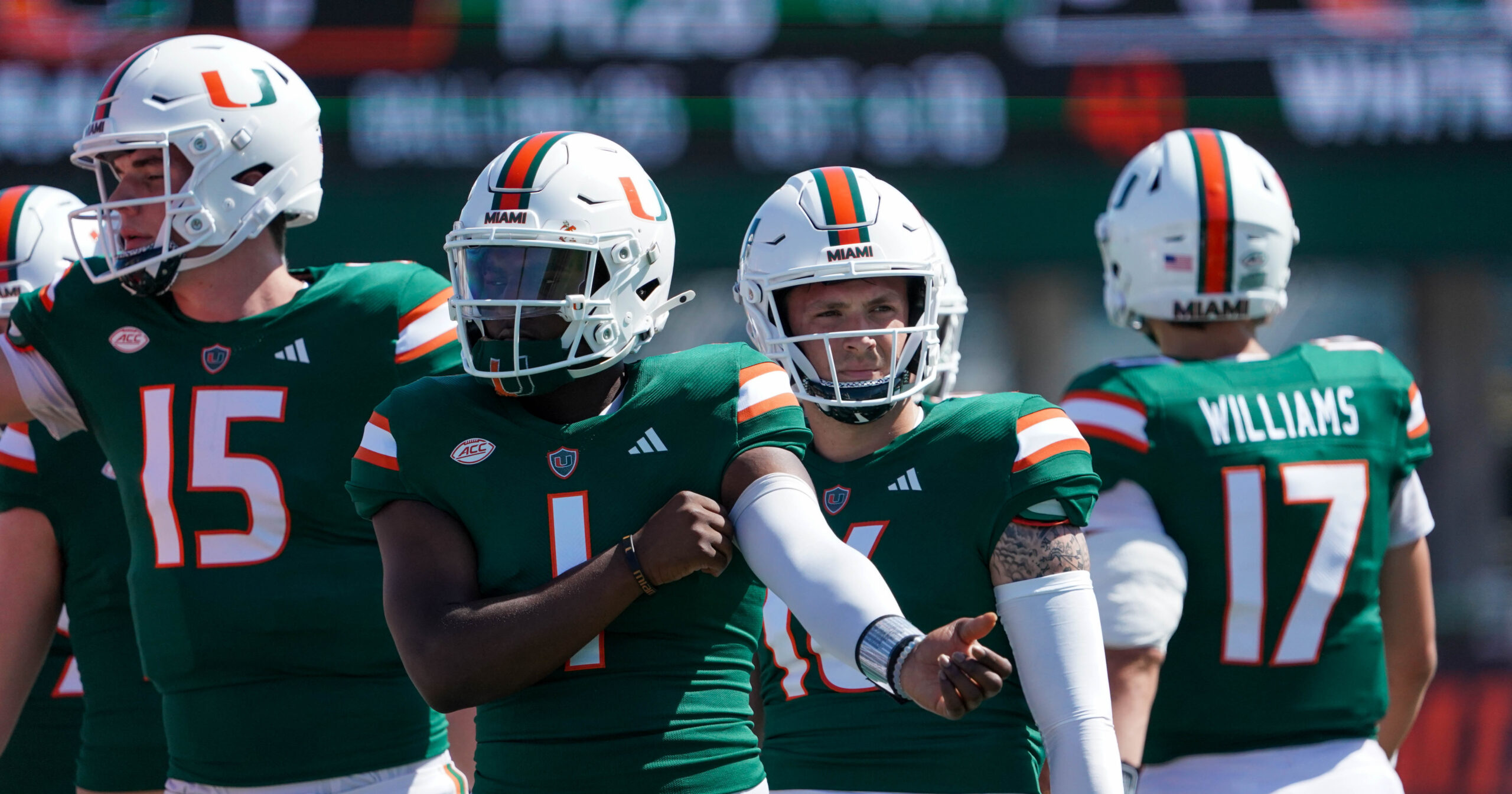ANALYSIS: Gauging Miami’s offensive roster strides from 2023 to now

Perhaps the best way to project a program’s success in a given year is a simple formula: Look at the prior year, position by position, and then gauge if there are overall upgrades based on what we have seen to this point.
So let’s get right to it, with the understanding that this is an opinion based off what we believe regarding each player and position. Today we are looking at the offense:
QUARTERBACK
This one’s about as easy as it gets to project, with a major upgrade in level of play from error-prone Tyler Van Dyke to Cam Ward. In addition to his interception problems Van Dyke was also injury-riddled, and the offense struggled with consistency the last two years with him behind center. The depth also wasn’t particularly good, with other starts going to guys like Jake Garcia, Jacurri Brown and Emory Williams, who were either not very good, very inexperienced or both. As for Ward? Well, he was a hair away from going to the NFL, where he would likely have been a middle round selection. His goal is to sneak into the first couple of rounds with a strong year, and don’t bet against it. He starred the last two seasons at Washington State, including 25 passing TDs, seven INTs and eight rushing scores this past season. Miami also has better depth with experienced Albany transfer Reese Poffenbarger plus Williams returning for year 2 after starting games as a true freshman vs. Clemson (a win) and FSU (a loss). Poffenbarger looked on point this spring and Williams was also sharp, so Miami in really good shape here. NET GAIN OR NET LOSS FROM LAST YEAR? Net Gain
RUNNING BACK
The healthy depth here wasn’t great in spring ball, with a true freshman and redshirt freshman (Chris Johnson, Chris Wheatley-Humphrey) the top two followed by TE/RB Elija Lofton. So it’s huge that Miami added Oregon star RB Damien Martinez out of the transfer portal. Also note that Mark Fletcher flashed as a true freshman starter, but his status for the season is in doubt off a major foot injury. Ajay Allen was a backup last year after transferring in from Nebraska and missed the spring with injury. TreVonte’ Citizen and Henry Parrish (starter with Fletcher last year) transferred out. So that leaves the only other backs on the roster the aforementioned Johnson (great speed, not an every-down back given his frame) and Wheatley-Humphrey along with summer arrival Jordan Lyle. Wheatley-Humphrey might have wound up on defense this spring if not for the need at running back, and Lyle has a good size/speed combination but will have to get acclimated to the offense quickly. So even with addition of Martinez, the depth here is questionable if Fletcher isn’t able to get back in form. But Martinez should be able to carry the load after starring at Oregon State. A 1,000-yard season is very much in the cards for him. NET GAIN OR NET LOSS FROM LAST YEAR? Net Gain
WIDE RECEIVER
Xavier Restrepo in Miami’s Spring Game (photo by Neil Gershman)
It’s always a big deal to return your top receivers off productive seasons, and Miami’s doing that with Xavier Restrepo (85 catches, 1,092 yards, six TDs) and Jacolby George (57-864-8). The losses here aren’t a lot to overcome – Colbie Young (47-563-5) and backup Brashad Smith (22-263-2). The Canes brought in Houston productive wideout Sam Brown (815 yards last season) to compete with Isaiah Horton as Young’s replacement, and don’t sleep on freshman JoJo Trader and Ny Carr or last year’s JUCO pickup Shemar Kirk, who had a strong spring game. Ray Ray Joseph also is in year 2 and has a potentially bright future. We thought the receivers were pretty good last year notwithstanding the QB issues, and the position should be better this year. Dare we dream of a pair of 1,000-yard receivers for the first time in Miami history? It’s not out of the realm of possibility. NET GAIN OR NET LOSS FROM LAST YEAR? Net gain
TIGHT END
This position was a mess a year ago with presumed starter Elijah Arroyo out almost the entire season. That left blocking tight end Cam McCormick as the main guy, but he just doesn’t really have receiving skills. It was true freshman Riley Williams who led this position as a pass catcher in limited reps with just 72 total yards. So there was a lot to be desired at a spot that Miami prides itself on having top receiving talent. Looking to this year? Arroyo looked good in his return to action this spring, and perhaps the best sign here isn’t just Williams bulking up and looking better but the emergence of true freshman Elija Lofton. Lofton lined up everywhere from running back to the slot to attached to the line and is a smooth route runner with sure hands. McCormick also is back, so there is a variety of tight end types that can help Miami win games in 2024. This position should quickly turn from a weakness to a strength. NET GAIN OR NET LOSS FROM LAST YEAR? Net Gain
OFFENSIVE LINE
There are three solid returning starters here in Jalen Rivers, Francis Mauigoa and Anez Cooper, who should be even better with another year under their belts. But the losses aren’t insignificant with center Matt Lee and left guard Javion Cohen leaving early for the NFL. The team addressed Lee’s loss in the first portal window, adding veteran Indiana starter Zach Carpenter. That leaves one open starting spot, and it’s most likely going to be filled by either Samson Okunlola (a former 5-star who was banged up most of last year as a true freshman), Matthew McCoy or Markel Bell (if Mauigoa moves to guard). We feel pretty good about this situation, and the depth is better than last year with Okunlola healthy and also the addition of Bell, who appears game ready. We think overall this line can be as good or better than last year’s that helped the backs average 5.1 yards per carry and allowed 16 sacks. NET GAIN OR NET LOSS FROM LAST YEAR? Status quo
The bottom line?
As you see above we grade every position as the same or improved from last year, and consider QB and WR in particular to be significantly upgraded. The OL is closest in the category of perhaps not being all that much better given the team needing to replace two of its top OL in Lee and Cohen.
So is it fair to expect a jump up from the 31.5 points this offense averaged a year ago?
For sure.
And if you think Cam Ward and his arsenal are a TD better than TVD and company then this could even become the first Miami team to average 39 or more points per game since 2002.
The post ANALYSIS: Gauging Miami’s offensive roster strides from 2023 to now appeared first on On3.
